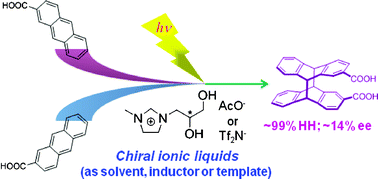Chiral ionic liquid-mediated photochirogenesis. Enantiodifferentiating photocyclodimerization of 2-anthracenecarboxylic acid†
Abstract
Enantiodifferentiating photocyclodimerization of

* Corresponding authors
a
Department of Applied Chemistry, Osaka University, 2-1 Yamada-oka, Suita, Japan
E-mail:
gaku@chem.eng.osaka-u.ac.jp, inoue@chem.eng.osaka-u.ac.jp
Fax: (+81) 6 6879 7923
Tel: (+81) 6 6879 7922
b
Dipartimento di Chimica e Chimica Industriale, Università di Pisa, via Risorgimento 35, 56126 Pisa, Italy
E-mail:
cinziac@farm.unipi.it
Fax: (+39) 050 2219669
Tel: (+39) 050 2219660
c Center for Advanced Science and Innovation, Osaka University, 2-1 Yamada-oka, Suita 565-0871, Japan
d Dipartmento di Chimica, Materiali e Ingegneria Chimica “G. Natta”, Politecnico di Milano, via Mancinelli 7, 20131 Milano, Italy
e CNR -Istituto di Chimica del Riconoscimento Molecolare, via L. Mancinelli 7, 20131 Milano, Italy
Enantiodifferentiating photocyclodimerization of

 Please wait while we load your content...
Something went wrong. Try again?
Please wait while we load your content...
Something went wrong. Try again?
G. Fukuhara, T. Okazaki, M. Lessi, M. Nishijima, C. Yang, T. Mori, A. Mele, F. Bellina, C. Chiappe and Y. Inoue, Org. Biomol. Chem., 2011, 9, 7105 DOI: 10.1039/C1OB05716B
To request permission to reproduce material from this article, please go to the Copyright Clearance Center request page.
If you are an author contributing to an RSC publication, you do not need to request permission provided correct acknowledgement is given.
If you are the author of this article, you do not need to request permission to reproduce figures and diagrams provided correct acknowledgement is given. If you want to reproduce the whole article in a third-party publication (excluding your thesis/dissertation for which permission is not required) please go to the Copyright Clearance Center request page.
Read more about how to correctly acknowledge RSC content.
 Fetching data from CrossRef.
Fetching data from CrossRef.
This may take some time to load.
Loading related content
